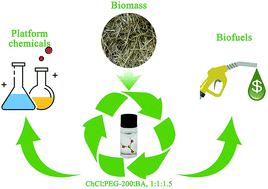当前位置:
X-MOL 学术
›
Green Chem.
›
论文详情
Our official English website, www.x-mol.net, welcomes your
feedback! (Note: you will need to create a separate account there.)
New ternary deep eutectic solvents for effective wheat straw deconstruction into its high-value utilization under near-neutral conditions
Green Chemistry ( IF 9.3 ) Pub Date : 2020-11-17 , DOI: 10.1039/d0gc03240a Yu-hui Ci 1, 2, 3, 4 , Fei Yu 1, 2, 3, 4 , Cheng-xuan Zhou 1, 2, 3, 4 , Hao-e Mo 1, 2, 3, 4 , Zu-yu Li 1, 2, 3, 4 , Yun-qian Ma 1, 2, 3, 4 , Li-hua Zang 1, 2, 3, 4
Green Chemistry ( IF 9.3 ) Pub Date : 2020-11-17 , DOI: 10.1039/d0gc03240a Yu-hui Ci 1, 2, 3, 4 , Fei Yu 1, 2, 3, 4 , Cheng-xuan Zhou 1, 2, 3, 4 , Hao-e Mo 1, 2, 3, 4 , Zu-yu Li 1, 2, 3, 4 , Yun-qian Ma 1, 2, 3, 4 , Li-hua Zang 1, 2, 3, 4
Affiliation

|
In order to extract lignin, a novel near-neutral deep eutectic solvent (DES) was developed to treat wheat straw which facilitated its subsequent enzymatic glycation. The DES, whose in situ complexation promotes lignin depolymerization, was composed of choline chloride (ChCl), boric acid (BA), and polyethylene glycol-200 (PEG-200). Our results showed that this kind of DES could dissolve a large amount of lignin and hemicellulose yet retained cellulose well. Under optimum conditions (DES ratio of 1 : 1 : 1.5, 120 °C, 4 h), the proportions of lignin and hemicellulose removed amounted to 88.39% and 84.38%, respectively, with enzymatic digestibility reaching 59.3% in the subsequent enzymatic saccharification with a limited timeframe (5 days) and low enzyme load (30 FPU g−1). The results also demonstrated that lignin's removal rate was positively correlated with the amount of BA used in the DES. The 2D-HSQC NMR, FTIR and TG analyses showed the regenerated lignin to be a typical H–G–S type retaining its intact structure (e.g., β-O-4, β-β, β-5, etc.), whose carbon chain backbone is stable. GPC analysis revealed that this extracted lignin had low molecular weight and a narrower distribution range. Density functional theory showed that BA could bond with –OH similar to Cl−, and it occupied more effective sites than Cl− to break the hydrogen-bonding network between lignin and cellulose. Importantly, the DES can be used multiple times without significantly reducing its efficiency, and its structure and properties remain virtually unchanged throughout the use cycle.
中文翻译:

在近中性条件下有效地将麦秸解构成高价值利用的新型三元深共熔溶剂
为了提取木质素,开发了一种新型的近中性深低共熔溶剂(DES)来处理小麦秸秆,从而促进其随后的酶促糖基化。DES的原位络合促进木质素解聚,它由氯化胆碱(ChCl),硼酸(BA)和聚乙二醇200(PEG-200)组成。我们的结果表明,这种DES可以溶解大量的木质素和半纤维素,同时又能很好地保留纤维素。在最佳条件下(DES比例为1:1:1.5,120°C,4 h),木质素和半纤维素的去除率分别达到88.39%和84.38%,在随后的酶促糖化中,酶解率达到59.3%。有限的时间范围(5天)和低的酶负荷(30 FPU g -1)。结果还表明,木质素的去除率与DES中BA的使用量呈正相关。2D-HSQC NMR,FTIR和TG分析表明,再生的木质素是典型的H–G–S型,保留了其完整的结构(例如,β-O-4,β-β,β-5等),其碳链主链是稳定的。GPC分析表明,该提取的木质素分子量低,分布范围较窄。密度泛函理论表明,BA能与-OH类似于Cl键- ,它占据更有效部位比氯-破坏木质素和纤维素之间的氢键网络。重要的是,DES可以多次使用而不会显着降低其效率,并且在整个使用周期中其结构和特性实际上保持不变。
更新日期:2020-11-25
中文翻译:

在近中性条件下有效地将麦秸解构成高价值利用的新型三元深共熔溶剂
为了提取木质素,开发了一种新型的近中性深低共熔溶剂(DES)来处理小麦秸秆,从而促进其随后的酶促糖基化。DES的原位络合促进木质素解聚,它由氯化胆碱(ChCl),硼酸(BA)和聚乙二醇200(PEG-200)组成。我们的结果表明,这种DES可以溶解大量的木质素和半纤维素,同时又能很好地保留纤维素。在最佳条件下(DES比例为1:1:1.5,120°C,4 h),木质素和半纤维素的去除率分别达到88.39%和84.38%,在随后的酶促糖化中,酶解率达到59.3%。有限的时间范围(5天)和低的酶负荷(30 FPU g -1)。结果还表明,木质素的去除率与DES中BA的使用量呈正相关。2D-HSQC NMR,FTIR和TG分析表明,再生的木质素是典型的H–G–S型,保留了其完整的结构(例如,β-O-4,β-β,β-5等),其碳链主链是稳定的。GPC分析表明,该提取的木质素分子量低,分布范围较窄。密度泛函理论表明,BA能与-OH类似于Cl键- ,它占据更有效部位比氯-破坏木质素和纤维素之间的氢键网络。重要的是,DES可以多次使用而不会显着降低其效率,并且在整个使用周期中其结构和特性实际上保持不变。











































 京公网安备 11010802027423号
京公网安备 11010802027423号